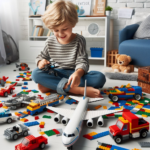Introduction to Toy Nostalgia
Toy nostalgia is a phenomenon that evokes a sense of fondness and emotional connection to toys from one’s childhood. As societies evolve, certain toys become timeless symbols of shared experiences, transcending generational divides. The allure of toys such as Barbie and LEGO is not merely about their physical forms but about the memories and emotions they encapsulate. These iconic toys often serve as a bridge linking childhood innocent play with adult reflections, marking significant moments in personal development.
The psychological aspects of nostalgia are deeply rooted in human cognition. Researchers suggest that nostalgia can elicit feelings of comfort, belonging, and continuity. When individuals interact with toys from their formative years, they are often reminded of carefree times, reinforcing a connection to their past. This emotional resonance is powerful, as it encourages adults to revisit their childhood through the lens of beloved toys, which may explain the resurgence in the popularity of vintage or retro items.
Additionally, the societal implications of toy nostalgia cannot be overlooked. As parents introduce toys like Barbie and LEGO to their children, they partake in a cycle of sharing experiences that fosters bonding. This generational exchange creates a shared narrative and builds a collective identity around beloved toys. The impact of toy nostalgia also extends to popular culture, where nostalgia-driven marketing campaigns often capitalize on children’s toys that have stood the test of time. Hence, toys that evoke nostalgia can drive consumer behavior and influence market trends in unprecedented ways.
The phenomenon of toy nostalgia illustrates the powerful emotional ties that individuals cultivate with their childhood belongings. As we explore this theme further, it becomes evident that the resonance of toys like Barbie and LEGO is much more than just playthings; they are integral to the complex tapestry of human experience that bridges childhood and adulthood.
The Evolution of Iconic Toys
Iconic toys such as Barbie and LEGO have a rich history that reflects not just advancements in design, but the broader cultural landscape in which they emerged. Barbie, introduced by Ruth Handler in 1959, was revolutionary for presenting a fashion doll that encouraged imaginative role-play and career exploration for young girls. Rooted in post-war America, Barbie’s initial appeal was shaped by the prevailing ideals of femininity, aspiration, and consumerism. Over the decades, Barbie has transformed to reflect societal shifts, introducing diverse characters and careers while promoting inclusivity and empowerment, thereby retaining her relevance in modern culture.
On the other hand, LEGO started as a simple wooden toy in 1932 in Denmark, evolving into the plastic interlocking bricks we recognize today by the late 1940s. Known for fostering creativity and engineering skills among children, LEGO’s evolution aligns with the educational trends that prioritize hands-on learning. In the late 20th and early 21st centuries, LEGO diversified its product lines, establishing franchises that resonate with contemporary pop culture, including collaborations with films and television. Such adaptations not only sustain LEGO’s appeal but also connect with nostalgic adults who grew up playing with the brand.
Both Barbie and LEGO exemplify how iconic toys have adapted to technological advancements and societal trends without losing their core identities. The development of digital platforms, for instance, has prompted both brands to expand into online gaming and interactive experiences, enhancing engagement among new generations of consumers. This ability to embrace change while maintaining nostalgic value is crucial for the continued success of these brands in a rapidly changing world.
The Emotional Impact of Toys
Toys occupy a significant space in the landscape of childhood, serving not only as instruments of play but also as catalysts for emotional experiences. The bonds formed through play can evoke a plethora of emotions, including joy, nostalgia, and a sense of belonging. Psychologists emphasize that toys are more than mere objects; they represent various facets of a child’s world, helping them navigate their feelings and experiences. When children engage with toys, they often connect deeply with the stories and identities those toys embody, leading to a profound emotional attachment.
As a child plays with their favorite toys, they often revisit memories associated with their family and social interactions. A worn-out teddy bear might symbolize comfort during a challenging time, while building blocks may remind them of collaborative play with siblings. Such emotional connections to toys can instill a lasting sense of security, as they serve as tangible reminders of carefree moments and cherished relationships. These memories solidify the importance of play in the emotional development of a child, encouraging creativity, empathy, and resilience as they grow.
Educators further support the notion that toys facilitate emotional growth. Through play, children learn to express their emotions and develop social skills as they interact with peers. The act of sharing toys, negotiating play rules, and imagining scenarios fosters emotional intelligence. Moreover, toys like action figures or creative sets can help children express their inner thoughts and feelings in a safe environment, allowing them to explore different identities and perspectives. This exploratory play is vital in honing their emotional responses and understanding of the world around them.
Thus, the emotional impact of toys extends far beyond mere amusement. These cherished objects reflect personal histories and contribute significantly to the emotional and social development of individuals during their formative years.
Cultural Significance of Nostalgic Toys
The cultural significance of nostalgic toys, such as Barbie and LEGO, extends far beyond mere playthings; they serve as reflections of societal values and historical periods. Toys often embody the zeitgeist of the era during which they were produced, revealing shifts in social norms, gender roles, and creative expression over the years. For instance, Barbie, introduced in 1959, represents both the aspirations and challenges faced by women across generations. Originally criticized for promoting unrealistic body standards, Barbie has since transformed, with diverse representations that highlight career achievements, multiculturalism, and empowerment. This evolution mirrors the ongoing conversation about gender equality and women’s roles in society.
Similarly, LEGO has transcended the realm of childhood entertainment to become a cultural icon that fosters creativity and innovation. Originally designed in Denmark during the mid-20th century, LEGO bricks encourage imaginative play, aligning with societal values surrounding creativity and self-expression. The LEGO Group’s recent initiatives towards inclusivity, such as introducing sets aimed at underrepresented groups and female builders, signify a deliberate attempt to resonate with contemporary cultural shifts. Such movements not only enhance the toy’s relevance but also reflect broader societal trends towards inclusivity and diversity.
Moreover, the nostalgia associated with these toys often results in multi-generational connections, allowing parents and grandparents to share their experiences with children. This intergenerational bonding fosters a deeper appreciation for cultural heritage, as children’s interaction with nostalgic toys provides opportunities to engage in discussions about history, identity, and personal values. As these toys continue to evolve, they encapsulate the dreams and aspirations of each generation, offering both a lens into the past and a roadmap for future cultural developments. By understanding the cultural significance of nostalgic toys, society can better recognize their role as carriers of collective memory and instruments of social change.
Marketing Nostalgia in the Toy Industry
The toy industry has long recognized the emotional resonance of nostalgia and utilizes it strategically in marketing campaigns. This phenomenon is particularly significant as it enables brands to connect with older consumers who have fond memories of their favorite toys while simultaneously introducing these icons to younger generations. Toy manufacturers employ various strategies to leverage this nostalgia effectively.
One prominent approach is through the release of remakes and special editions of classic toys. For instance, iconic brands like Barbie and LEGO frequently launch updated versions of their products, incorporating contemporary designs while retaining the elements that made them beloved in the first place. This not only appeals to adult collectors but also allows new fans to experience the original charm of these toys. By tapping into the nostalgia surrounding these brands, manufacturers cultivate a sense of familiarity and trust that often translates into purchasing decisions.
Collaborations with popular franchises further enhance the appeal of nostalgic marketing in toys. By aligning well-established toy brands with contemporary movies, television shows, or video games, manufacturers can capture the attention of both nostalgic adults and curious children. These collaborations often celebrate beloved characters or stories from the past, reinforcing a shared cultural experience. For example, partnerships involving superheroes or animated favorites allow toy companies to remain relevant while valuing their heritage.
Additionally, nostalgia-driven marketing campaigns frequently utilize storytelling techniques. Advertisements infused with anecdotes and sentimental messaging resonate deeply with consumers, eliciting memories of childhood and the joy associated with playtime. By invoking such emotions, toy brands can successfully foster connections that transcend generational boundaries, ultimately elevating brand loyalty and engagement.
In sum, the toy industry cleverly harnesses nostalgia through remakes, special editions, collaborations, and engaging storytelling. Through these strategies, manufacturers create a unique blend of the past and present, bridging the gap between generations while ensuring the enduring appeal of cherished toys.
The Role of Social Media in Toy Nostalgia
In recent years, social media platforms such as Instagram, TikTok, and YouTube have transformed the landscape of nostalgia surrounding toys. These platforms not only provide a space for nostalgic reminiscence but also serve as pivotal environments where individuals can express their passion for toys from their youth. By sharing images, videos, and stories, users help revitalize interest in toys that may have faded from mainstream consciousness, allowing new generations to discover their vintage counterparts.
Influencers play a significant role in cultivating this toy nostalgia. Many theme their content around specific toy brands, showcasing collections of action figures, dolls, and building sets that resonate with audiences longing for their childhood. These influencers often create unboxing videos, reviews, and even tutorials, fostering a sense of community among followers who share similar interests. The visual nature of platforms like Instagram and TikTok makes it easy for users to engage with and appreciate nostalgic toys through striking imagery and emotional storytelling.
Moreover, social media has led to the formation of dedicated communities. Facebook groups, Instagram hashtags, and TikTok challenges centered around nostalgic toys enable collectors to connect, share their experiences, and trade items. This growing online community can amplify enthusiasm surrounding specific brands, contributing to a resurgence in their popularity. The merging of childhood memories with adult collecting habits showcases how social media builds bridges between generations—allowing today’s adult fans to share their cherished experiences with the youth of today.
Furthermore, the interactive nature of these platforms encourages users to curate their nostalgia. By participating in discussions, sharing personal anecdotes, and even creating nostalgia-themed challenges, collectors enhance their emotional connection to both toys and each other. In this manner, social media not only preserves the memories associated with these toys but actively revitalizes interest, creating a dynamic and engaging bond among enthusiasts.
Collecting and Preserving Toy Nostalgia
Toy collecting has emerged as both a hobby and an investment strategy, driven by the allure of nostalgia. Many individuals find themselves drawn to toys from their childhood, seeking to recapture the innocence and joy of their formative years. This phenomenon can be attributed to the profound emotional connections that these items evoke. Collectors often describe a sense of comfort and familiarity when they encounter toys that were significant during their childhood, leading to personal fulfillment that transcends mere ownership.
The market for vintage toys has flourished as a result of this desire to collect. Auction houses, online marketplaces, and specialized toy conventions now showcase a plethora of iconic toys from decades past. Collectors are on the lookout for specific brands, such as LEGO or Barbie, which have become cultural touchstones. These items often see incredible appreciation in value over time, making them not only a nostalgic pursuit but also a potentially lucrative investment. Notably, toys that are still in their original packaging or have been well-preserved tend to command higher prices, underscoring the importance of careful preservation.
Preserving toy nostalgia is crucial, as it safeguards not only the physical items but also the memories they represent. Proper storage techniques, such as climate control and protective casing, can significantly extend the lifespan of vintage toys. Additionally, many collectors engage in communities or forums where they share tips on restoration and preservation, further enhancing their connection to the hobby. This collaborative spirit fosters an appreciation for the craftsmanship that went into creating these beloved toys, ultimately enriching the experience of toy collecting.
The act of collecting and preserving nostalgic toys serves to not only commemorate personal histories but also to celebrate the broader cultural significance of these artifacts. Each collectible tells a story, intertwined with the values and memories of a generation, making them invaluable both personally and historically.
The Future of Nostalgic Toys
The intersection of nostalgia and toys is a dynamic area that reflects changing cultural values and technological advancements. As such, the future of nostalgic toys is likely to be shaped significantly by various innovations and trends in the toy industry. One prominent aspect of this evolution is technology, particularly the integration of augmented reality (AR) and virtual gaming experiences. These technologies promise to redefine how children engage with traditional toys, adding layers of interaction that were previously unattainable.
For instance, we can expect to see nostalgic toy brands leveraging AR to create immersive experiences. By combining physical toys with digital environments, children could interact with their favorite characters in entirely new ways. Imagine classic figurines from beloved franchises coming to life through a smartphone app, allowing kids to explore their imaginary worlds with enhanced visuals and interactive storylines. This fusion of digital and physical play could breathe new life into nostalgia while keeping engagement levels high.
Furthermore, the integration of video games is poised to play a crucial role in the future of nostalgic toys. Game developers have increasingly sought partnerships with established toy brands to create interactive products that resonate with both parents and children. This strategy not only caters to today’s tech-savvy youth but may also tap into parental nostalgia, making the prospect of purchasing such toys more appealing. The convergence of gaming and traditional toys could result in hybrid products that incorporate both storytelling and play, fostering creativity and imaginative exploration.
As these trends unfold, the challenge will be to maintain the essence of nostalgia while embracing innovation. Toy manufacturers must strike a balance between preserving cherished memories and adapting to the evolving expectations of new generations. This delicate interplay will ultimately determine the trajectory of nostalgic toys in the years to come.
Conclusion and Reflections on Toy Nostalgia
Toy nostalgia plays a significant role in shaping our cultural landscape, serving as more than just a fond recollection of childhood. It encapsulates the emotional connections formed through play and reflects the societal values of different eras. As we have explored throughout this blog post, toys such as Barbie and LEGO have not only endured but have also evolved, adapting to contemporary issues while retaining their nostalgic allure. This adaptability ensures that generations of children and adults alike continue to find joy and comfort in these timeless objects.
The psychological impact of toys extends beyond mere entertainment; they become symbols of identity for individuals. Many people identify closely with the toys they cherished during their formative years, which can influence their values, aspirations, and memories. This deep-rooted association highlights the broader significance of toy nostalgia, as it helps create a shared cultural experience among different demographics, uniting individuals through the commonality of past play experiences.
Moreover, the nostalgia for toys often serves as a bridge between generations. Parents who grew up with iconic toys frequently pass them down to their children, thereby creating shared experiences that enrich family bonds. This cyclical nature of toy nostalgia reinforces the importance of preserving old toys and embracing their place in our collective memory. By cherishing these tokens of our past, we not only keep our personal histories alive but also contribute to a broader understanding of cultural identity over time.
In conclusion, toy nostalgia is a powerful phenomenon that resonates on various levels, shaping personal identities while reflecting societal changes. As readers revisit their own cherished toy memories, they are encouraged to consider the significance these objects hold in their lives and the broader cultural narratives that they weave. Embracing this nostalgia can enrich our understanding of both ourselves and the world around us, providing a sense of connection in an ever-evolving society.



